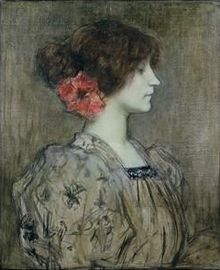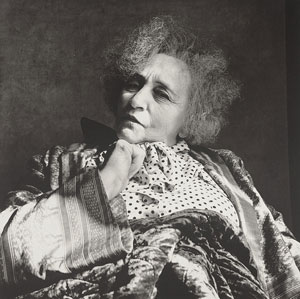 It’s been quite a while since I last read anything by Colette, one of my favorite writers, so I recently decided to spend some time getting reacquainted with her, and this week’s almanac entries will reflect the fruits of my labor (if that’s the word for so pleasurable a task).
It’s been quite a while since I last read anything by Colette, one of my favorite writers, so I recently decided to spend some time getting reacquainted with her, and this week’s almanac entries will reflect the fruits of my labor (if that’s the word for so pleasurable a task).
In addition to being a remarkable writer, Colette was also one of the most photogenic artists of the twentieth century, not merely in her youth but long after arthritis had gnarled her features and condemned her to an indoor life of immobility and pain. The painting that you see above (the artist is Jacques Humbert) dates from 1896, and shows her as a beautiful young woman, teetering on the edge of knowingness. The second image is a reproduction of a photographic portrait of Colette shot by Irving Penn in 1951. Both images capture something of her intriguing, ever-elusive essence.
 I also spent a few minutes trolling through YouTube in search of Colette-related video, and came up with two clips from Colette, a film documentary made in 1951 by Yannick Bellon. (Yes, it’s in French, but it’s subtitled.) Alas, I can’t embed the clips, but you can view them by going here and here. Colette herself appears on camera and can be heard speaking in both sequences, the second of which is a survey of her fascinating career as a music-hall performer.
I also spent a few minutes trolling through YouTube in search of Colette-related video, and came up with two clips from Colette, a film documentary made in 1951 by Yannick Bellon. (Yes, it’s in French, but it’s subtitled.) Alas, I can’t embed the clips, but you can view them by going here and here. Colette herself appears on camera and can be heard speaking in both sequences, the second of which is a survey of her fascinating career as a music-hall performer.
If you happen to be a Francophone, you can also listen to a 1950 radio program about Colette by going here. The piece of music heard at the beginning is Ravel’s Jeux d’eau.
* * *
The Glyndebourne Festival’s 1987 production of Maurice Ravel’s L’enfant et les sortilèges, designed by Maurice Sendak, directed by Frank Corsaro, and conducted by Simon Rattle. The libretto is by Colette:
Terry Teachout on the arts in New York City
An ArtsJournal Blog
